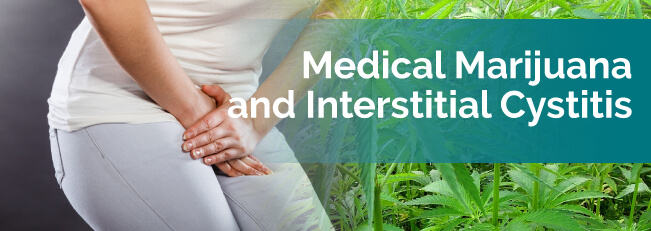
Unlike urinary tract infections, a bacterial infection does not cause interstitial cystitis, meaning antibiotics are of no help. While there is no known cure for the disease, there are, however, some options available for those hoping to relieve their chronic symptoms. One of these beneficial options would be medicinal marijuana.
Interstitial cystitis, also known as painful bladder syndrome, is a chronic condition. It causes feelings of pain and pressure in the bladder. In some cases, it can also cause pelvic pain.
Few studies are available that examine the role medical marijuana can play in helping individuals with interstitial cystitis. It’s thought that cannabis can help ease the pain in people with the condition though.
Marijuana helps trigger the activation of the CB2 receptors which are seemingly the primary inhabitants of inflammation. Marijuana may also reduce swelling and bladder weight. When considering that phytocannabinoids like tetrahydrocannabinol (THC) and cannabidiol (CBD) are known to activate the CB2 receptors, one can conclude that medical marijuana could be of benefit in the treatment of chronic bladder diseases.
One study, published in 2014 in the “Journal of Urology,” examined the effect of a cannabinoid receptor two on a group of mice with established cystitis. The mice were treated with GP1a, a cannabinoid receptor two agonist. The researchers concluded that GP1a could be potentially therapeutic for the treatment of interstitial cystitis because the mice had a decrease in inflammation and their cystitis after treatment.
An earlier study, from 2003, examined the effect of cannabis on interstitial cystitis in a woman. The 31-year-old woman was given two synthetic cannabinoid medications, nabilone and dronabinol. After the nabilone had caused unpleasant side effects, such as hallucinations, the patient switched to the dronabinol. The dronabinol helped to ease her pain and didn’t produce the same side effects.
Strains that may help alleviate your interstitial cystitis include:
Side effects from medical cannabis use are minimal and include nausea or headaches, both of which are minor and temporary. Medical marijuana could help ease the pain and inflammation people with interstitial cystitis experience. If you are one of the millions of people in the US who is dealing with the pain and other symptoms of painful bladder syndrome, medical cannabis is worth looking into.
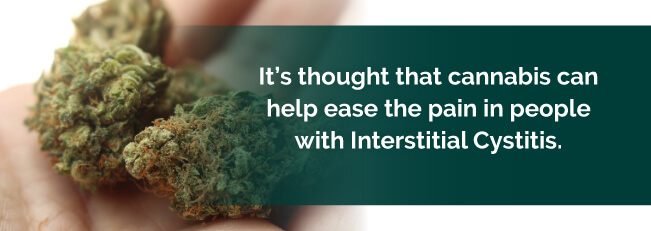
Medical cannabis can also be prescribed to treat chronic pain or other bladder symptoms, which interstitial cystitis may qualify as, depending on your severity of painful bladder syndrome. You don’t have to live with the pain or feeling that you have to go all the time. Search our site to find a compassionate and educated medical marijuana doctor in your state.
Find A Doctor Find A Dispensary
Although there may have been cases earlier in human history, the first record of interstitial cystitis dates to the early 1800s. Dr. Philip Syng Physick, a surgeon in Philadelphia, recorded a description of a bladder that had what he called an ulcer. The bladder had symptoms similar to one with a bladder stone. The patient with the condition also had pain in the area and an urgent, frequent need to urinate.
According to a surgeon in Philadelphia, Dr. Joseph Parrish, Dr. Physick called the illness, “tic douloureux of the bladder.” “Tic douloureux” is also the name of a condition that causes sharp, stabbing pain in one or more areas of the face.
It wasn’t until 1876 that the condition got the name it’s known by today — interstitial cystitis. The condition was described in a book published by Samuel D. Gross.
A few years later, in 1878, Dr. Alexander Skene published the book, “Diseases of the Bladder and Urethra in Women,” and noted that the illness seemed to be connected to inflammation in the bladder. Throughout the 19th century, interstitial cystitis was used as a catch-all phrase to describe a variety of problems that could be linked to bladder inflammation. It wasn’t until later that the name was used to describe one specific condition.
The development of the cystoscope in the early 1900s changed the way that doctors diagnosed the condition. A Dr. Guy Hunner used a cystoscope to examine the bladders of patients and made the discovery that many of those bladders had what appeared to be ulcers.
These “ulcers” were lesions on the bladder wall, but the name “Hunner’s Ulcers” caught on. It would be several more decades before doctors realized that many patients with painful bladder syndrome didn’t have ulcers or lesions.
While the earliest patients with interstitial cystitis were women, the condition also occurs in men and children. One study in the early 1940s examined interstitial cystitis in males.
Understanding of interstitial cystitis continued to evolve throughout the 20th century. In the late 1940s, a Dr. J.R. Hand established a grading system for the lesions found in the ulcers. He also noted several, “dot-like bleeding points,” in the bladders he examined.
Dr. Hand’s grading system is as follows:
After years of confusion over the disease’s name and confusion over what it was, the National Institute of Diabetes and Digestive and Kidney Diseases (NIDDK) created a definition for interstitial cystitis in 1987. The definition of the disease was meant to be used for study and research — not to diagnose patients.
The focus of the NIDDK’s definition was on lesions and bladder wall findings. Interestingly enough, patients under the age of 18 couldn’t have the condition, based on the NIDDK’s original definition. People with symptoms that lasted for less than nine months also didn’t qualify as having interstitial cystitis.
In 2002, a new name for interstitial cystitis, painful bladder syndrome, was introduced by the International Continence Society. The name change was meant to acknowledge the fact that not every individual with the condition has damage to the bladder wall. The American Urological Association suggested a combined name, interstitial cystitis/painful bladder syndrome, in 2011.
The good news about interstitial cystitis is that it’s not a common condition. When stricter diagnostic criteria were in place, only about 0.1 percent of people had it. That percentage has increased to two percent of women worldwide as the definition of the condition has changed.
In the US, anywhere from three to eight million women have painful bladder syndrome. The condition is far more common in women than in men. It might also be more common in Caucasian women than in other races or ethnicities.
Whether the condition affects your quality of life depends on several factors. Some people with painful bladder syndrome might not have severe symptoms. It’s also possible for symptoms to only flare up at certain times, such as during menstruation or after sex.
In more serious cases, the condition can have a substantial effect on a person’s quality of life. For example, some people with painful bladder syndrome might get up a lot at night to urinate or have a constant urge to urinate. They might not get a full night’s sleep on a regular basis as a result.
The constant pain can also affect a person’s mental health. Some individuals with interstitial cystitis report feeling depressed, as there is an occasional connection between constant pain and depression.
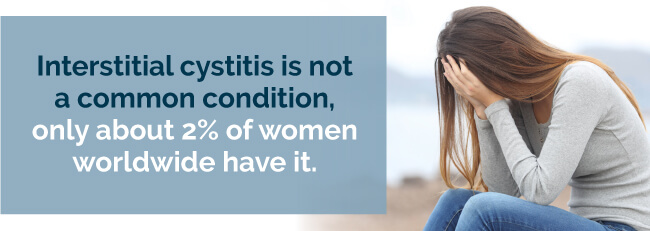
Many theories and hypotheses exist about the cause of painful bladder syndrome, but no known cause exists. Some people, such as women over 30 years of age, have a higher risk than others for developing interstitial cystitis. Additional factors that raise your risk of interstitial cystitis include:
Painful bladder syndrome may have an autoimmune disease nature according to studies. When a person has an autoimmune disease, the immune system gets confused and attacks healthy cells in the body. Interstitial cystitis’ relation to an autoimmune disorder is its tendency to coexist with other autoimmune diseases and develop in families with a history of painful bladder syndrome.
The symptoms of interstitial cystitis vary from patient to patient. While some people may not notice their symptoms, other can find their symptoms very debilitating.
Symptoms of the condition fall into three categories:
The pain a person experiences due to interstitial cystitis can take many forms. For example, some people feel pain in their bladder as it fills up while others only feel a slight discomfort. The pain is markedly different from the discomfort you might feel when your bladder is full, and you need to pee.
After urinating, the pain in the bladder usually subsides for a while. Some people don’t feel pain all the time, but rather have occasional flare-ups.
It’s also possible to feel pain in other areas due to interstitial cystitis. For example, women and men might feel spasms of pain in the perineum or pelvic area. The pain can become worse during sex for women.
The need to urinate often is another common symptom of painful bladder syndrome. More than 90 percent of patients with the condition experience frequent urination. Although the exact frequency can vary, some people may have to pee 60 times over the course of a single day.
Urgent urination is the sudden need to go. It occurs in about 84 percent of people with interstitial cystitis. In some cases, the need to urinate occurs at night and can cause a person to get up and go to the bathroom every 30 or 15 minutes.
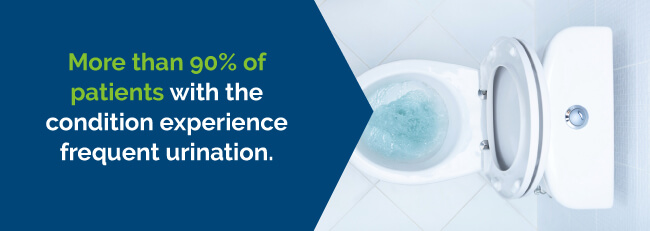
Treating interstitial cystitis can be tricky, as there’s no magic cure or one effective treatment option for everybody. Usually, treatment takes several forms, ranging from making changes to your habits to physical therapy, medication, and surgery.
Your treatment depends on the severity of your condition and whether a less invasive option has been effective or not. Treatments include:
Certain foods can trigger the symptoms of interstitial cystitis in some patients. Often called the “four C’s” these items include carbonated drinks, foods and drinks with caffeine, foods with a high amount of vitamin C and citrus fruits. Similarly, foods that are acidic, such as pickles and tomatoes, can also trigger attacks for some people.
If you think that your symptoms are connected to what you eat, try keeping a diary and recording everything you eat and drink daily to see if there is a connection.
In cases where lifestyle changes, over-the-counter medicines and therapy haven’t helped, a doctor might prescribe something stronger, such as an antidepressant to relax the bladder or an antihistamine to reduce the activity in the bladder wall. The side effects from antidepressants can include dry mouth, weight gain, heart problems and, in some instances, cognitive decline.
One medicine is FDA approved for treating interstitial cystitis. Pentosan polysulfate might help relieve pain and other symptoms by restoring the bladder wall’s coating. The prescription drug can take up to six months to improve symptoms. Side effects can include sleep problems, moodiness, hair loss and stomach pain.
A doctor might perform something known as bladder instillation. During it, they thread a catheter into the bladder and wash the inside of the bladder with a medication that can reduce irritation and inflammation. Treatment takes about 15 minutes and is usually every week or so for about two months. Many people see an improvement after the third or fourth treatment session.
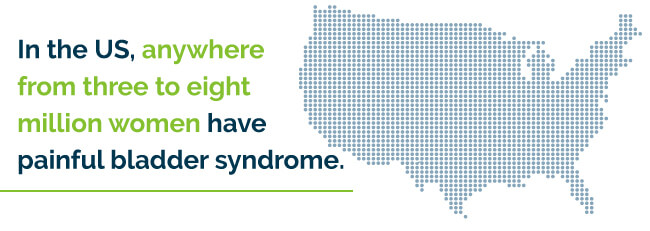
Another way to treat the bladder is to stretch it. During this treatment, your doctor will expand your bladder by filling it with liquid. While it can help ease the pain in some people, the treatment can also make pain worse several days later.
Because treating interstitial cystitis is a lifelong challenge for patients, many have sought alternative treatments that can ease their discomfort, such as medical marijuana.